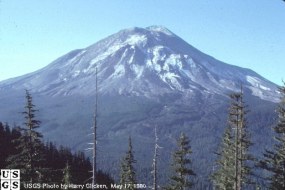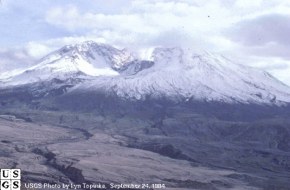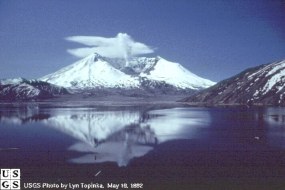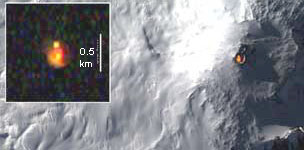





Day Before & Soon After the May 18, 1980 Eruption

Both images taken from Johnston's Ridge, six miles (10 km) northwest of the volcano.








On May 18, 1980, Mount St. Helens, the smallest of the Cascade volcanoes,began spewing vents of steam and ash (picture above, left). At 8:32 a.m. Pacific Daylight Time, a magnitude 5.1 earthquake shook Mount St. Helens, and the bulge and surrounding area slid away in a gigantic rockslide and debris avalanche, releasing pressure and triggering a major pumice and ash eruption (picture above, center - click for more eruption images). Thirteen-hundred feet of the peak collapsed or blew outwards, filling 24 square miles of valley with a debris avalanche and damaging 250 square miles of recreation, timber, and private lands with its lateral blast. The slopes of Smith Creek valley, (picture above, right) east of Mount St. Helens, are littered with trees blown down by the lateral blast. Two U.S. Geological Survey scientists in the lower right of the picture (in the circle--get out your microscope) are dwarfed by the fallen timbers. The direction of the blast, shown from left to right, is apparent in the alignment of the downed trees. Over four billion board feet of usable timber, enough to build 150,000 homes, was damaged or destroyed. An estimated 200 million cubic yards of material was deposited directly by lahars (volcanic mudflows) into the surrounding river channels. Sixty people were killed or are still missing.
Volcano eruptions are continuously active throughout the globe, and they remain an ever-present source of both danger and awe for those in the affected regions.
Spirit Lake, Before and After Mount St. Helens Eruption
Spirit Lake, once surrounded by lush forest (picture above, left), is within the area devastated by blast. Remnants of the forest float on the surface of the lake in the picture above, right, and the snow-draped crest of another Cascade volcano, Mt. Rainier (14,410 ft.), is visible in the distance.




Mount St. Helens National Volcanic Monument Live Cam









Antarctica's Mount Erebus
NASA's new "intelligent" software guides satellite discovery of active volcano.


Italy's Mount Etna
Europe's most active volcano, currently erupting, is imaged with others by satellite.


Mexico's Popocatepetl Volcano
currently erupting, covered by real-time live cam.

Where are the largest, most active volcanoes in the solar system?

Copyright © Writer - All rights
reserved

